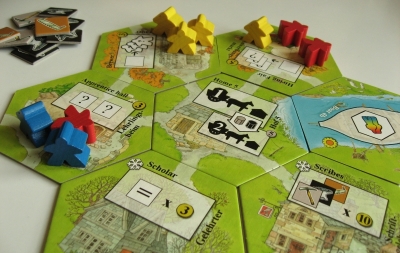Like last time, we again started out with a quick game of Love Letter while we waited for late arrivals. This time we found that players were winning rounds without getting very deep into the deck, which is strange. However, one thing that didn’t change was that beginners luck again carried the day…
Next we quickly played a new game, Diavolo. This is a dice rolling game where players take it in turns to roll dice and depending on the outcome of the “Order” die, dive for a cute little imp. If they fail to grab one (or get the wrong one), the player loses a gem and the last person to lose all their gems is the winner. We all found this game very stressful so we had one quick round of an old favourite, No Thanks! as the last player arrived and went to the bar.
Once again, our less experienced players were otherwise engaged, so we decided to forego Ticket to Ride and play something we enjoyed a couple of months ago, namely The Speicherstadt. This is a clever little auction game that is relatively quick to play and easy to teach, but has a lot of strategy. In short, cards are turned over and players take it in turns to place one of their “Village People” next to the card they would like to buy: contracts, ships (use to fulfil the contracts), firemen (to protect against inferno) etc.. The first player to bid for a card has first refusal for that card, but the price they must pay is equal to the total number of “Village People” next to the card. If they decline, then the next player has the choice, and the cost has reduced by one. Despite the fact that the different players seemed to employ quite different strategies it ended a very close game. For example, Blue eschewed firemen and ended up taking nearly all the negative points due to fires. Thus, Blue was some twenty points adrift at the back before the final accounting although they had a couple of valuable contracts and the warehouse. In contrast, White invested heavily in firemen, and was way out in front, but had less to add in the final reckoning. White and Blue ended level on points in last place, but only two points behind the winner who had engaged in more trading.
Finally, we just managed to squeeze in a game of Keyflower. This is a really beautiful resource management and bidding game where players use meeples (or “Keyples” as they are known here) both as currency for bidding and as workers to generate resources. Played over four Seasons, with new tiles available at the start of each one, players take it in turns to bid for the different tiles. However, the catch is that once a bid has been made, any subsequent bids for that tile must be both larger and made with the same colour. In addition to the colour management, there are lots of other really elegant aspects to this game. For example, players can place workers on tiles and use the products during that same Season, thus, if a player needs red for bidding, they may be able to use a worker to obtain the necessary Keyples. This means you rarely find you can’t do anything, but you often can’t do exactly what you want. Although it was a new release at the end of last year, we had all played it before, so we just had a quick reminder of the rules as we set up and then launched into it. In contrast to the last game, this was a bit of a white wash with the leader wining by some thirty points. What was particularly interesting, however, was that this was based on a skill tile strategy which netted some sixty points at the end of the game. None of us had ever found them all that useful before, presumably at least partly because the right tiles had never come up.
Learning Outcome: In some games, you can be quite convinced you are losing and be very, very wrong.




Pingback: 25th June 2013 | boardGOATS
Pingback: 3rd September 2013 | boardGOATS
Pingback: 17th December 2013 | boardGOATS